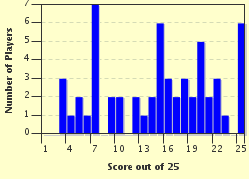Quiz Answer Key and Fun Facts
1. My name means "Dragon claw". I was a large Ornithopod dinosaur and I lived in Portugal during the Kimmeridgian and Tithonian stages of the late Jurassic period. Who am I?
2. I was a medium-sized Stegosaur with a name meaning "Jia-ling River lizard". I lived in China during the Oxfordian stage of the late Jurassic period. Who am I?
3. Who am I? I lived in England, France and Portugal during the Oxfordian and Kimmeridgian stages of the late Jurassic period. I was a large Stegosaur and my name means "Very pointy lizard".
4. Who am I? I was a small Nodosaur. My name means "Dragon's armour" and I lived in Portugal during the Kimmeridgian stage of the late Jurassic period.
5. Who am I? I lived in Japan and China during the Barremian stage of the early Cretaceous period. I was a small semi-aquatic lizard and my name means "Manchu crocodile".
6. I was named after a city near where my fossils were first discovered. I was a small crocodile and I lived in Spain, Belgium and southern England during the Berriasian stage of the early Cretaceous period. Who am I?
7. I was a Pterosaur with a very peculiar mouth. Instead of teeth, I had a brush-like arrangement of long, elastic bristles in my lower jaw. My name means "Southern wing" and I lived in South America during the Albian stage of the early Cretaceous period. Who am I?
8. I lived in South America during the Aptian stage of the early Cretaceous period. I was a large Pterosaur with a bizarre-looking crest on my head. My name means "Old one". Who am I?
9. Who am I? I was a large Theropod with a name meaning "New hunter". I lived on the Isle of Wight (southern England) during the Barremian and Aptian stages of the early Cretaceous period.
10. Who am I? I lived on the Isle of Wight during the Barremian stage of the early Cretaceous period. I was a medium-sized Theropod, the earliest-known Tyrannosaur and my name means "Dawn tyrant".
11. Who am I? I was a small Theropod. My name means "Tail feather" and I lived in China during the Barremian stage of the early Cretaceous period.
12. I lived in the USA during the Aptian and Albian stages of the early Cretaceous period. I was an early Therizinosaur - a group of carnivorous dinosaurs that developed into herbivores. My name means "Sickle bearer". Who am I?
13. My name means "Hidden flyer". I was a small Dromaeosaur and I lived in China during the Barremian and Aptian stages of the early Cretaceous period. Who am I?
14. I was a small Theropod, the earliest-known Dromaeosaur. My name means "Graceful thief" and I lived in China during the Valanginian, Hauterivian and Barremian stages of the early Cretaceous period. Who am I?
15. Who am I? I lived in China during the Barremian stage of the early Cretaceous period. I was a tiny bird, no bigger than a modern sparrow, and my name means "Chinese bird".
16. Who am I? My name means "Pointed beak bird". I was a small bird and I lived in China during the Barremian stage of the early Cretaceous period.
17. Who am I? I was a small bird, similar to modern penguins. My name means "Sea bird" and I lived in southern England during the Albian stage to the early Cretaceous period.
18. My name means "Utah's hunter". I was the largest known Dromaeosaur (as big as the raptors featured in 'Jurassic Park') and I lived in the USA during the Barremian stage of the early Cretaceous period. Who am I?
19. I was a large Theropod dinosaur with a name meaning "Crocodile mimic" (due to the shape of my head). I lived in Africa during the Aptian stage of the early Cretaceous period. Who am I?
20. I am a Sauropod dinosaur. I lived in the USA during the Albian stage of the early Cretaceous period and I was named after a Greek god. Who am I?
21. Who am I? I lived in South America during the Albian stage of the early Cretaceous period. I was a Sauropod dinosaur and I was named after the place where my fossils were found.
22. Who am I? My name means "Tendon lizard". I was a medium-sized Ornithopod dinosaur and I lived in the USA during the Aptian and Albian stages of the early Cretaceous period.
23. Who am I? I lived in Mongolia during the Aptian and Albian stages of the early Cretaceous period. My name means "High nose" and I was a large Ornithopod dinosaur.
24. My name means "Ancient horned face". I was a small early Ceratopsian and I lived in China during the Barremian and Aptian stages of the early Cretaceous period. Who am I?
25. I was a medium-sized Nodosaur with a name meaning "Spiny scute". I lived in southern England during the Aptian and Cenomanian stages of the early Cretaceous period. Who am I?
Source: Author
ElusiveDream
This quiz was reviewed by FunTrivia editor
rossian before going online.
Any errors found in FunTrivia content are routinely corrected through our feedback system.

